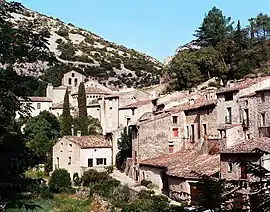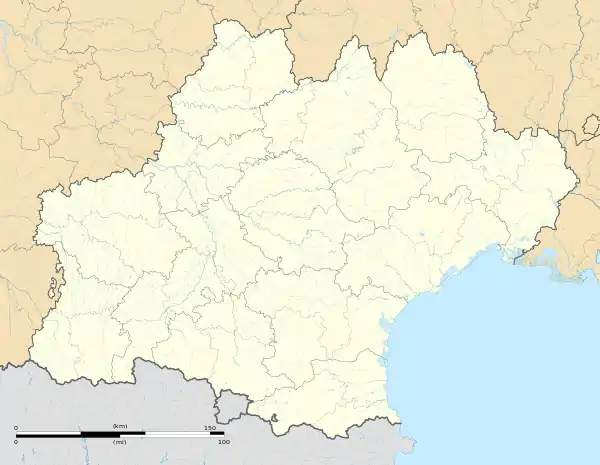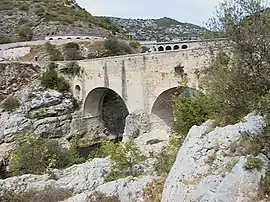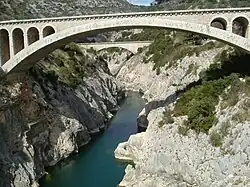Saint-Guilhem-le-Désert
Saint-Guilhem-le-Désert (French pronunciation: [sɛ̃ ɡijɛm lə dezɛʁ] or [sɛ̃ ɡilɛm lə dezɛʁ]; Occitan: Sant Guilhèm dau Desèrt) is a commune in the Hérault department in the Occitanie region in southern France. Situated where the Gellone river's narrow valley meets the steep-sided gorge of the river Hérault, Saint-Guilhem-le-Désert is essentially a medieval village located on the Chemin de St-Jacques (Way of St. James) pilgrim route to Santiago de Compostella.
Saint-Guilhem-le-Désert | |
|---|---|
 Gellone monastery | |
.svg.png.webp) Coat of arms | |
Location of Saint-Guilhem-le-Désert | |
 Saint-Guilhem-le-Désert  Saint-Guilhem-le-Désert | |
| Coordinates: 43°44′05″N 3°33′02″E | |
| Country | France |
| Region | Occitania |
| Department | Hérault |
| Arrondissement | Lodève |
| Canton | Gignac |
| Government | |
| • Mayor (2020–2026) | Robert Siegel[1] |
| Area 1 | 38.64 km2 (14.92 sq mi) |
| Population | 243 |
| • Density | 6.3/km2 (16/sq mi) |
| Time zone | UTC+01:00 (CET) |
| • Summer (DST) | UTC+02:00 (CEST) |
| INSEE/Postal code | 34261 /34150 |
| Elevation | 54–812 m (177–2,664 ft) (avg. 89 m or 292 ft) |
| 1 French Land Register data, which excludes lakes, ponds, glaciers > 1 km2 (0.386 sq mi or 247 acres) and river estuaries. | |
Geography
The municipality of Saint-Guilhem covers nearly 40km² in area. The town is served by two departmental roads - the D122 and D4. The nearest town is Saint-André-de-Sangonis (12 km away) and , Gignac (15 km away). Montpellier, Lodève and Ganges (which stands near the source of the Hérault) are all about 35 km away.
The town has retained a medieval appearance. It is located on the borders of the Massif Central, in the middle valley of the Hérault, north of the department of the same name. The territory of the town lies in an intramontane zone formed by the extension of the Séranne mountain and the Cellette mountain a few kilometres from the Garrigues of the plain of Languedoc.
History
The village has maintained its historic state. Because of its isolation, in 806 Saint Guilhem established the monastery of Gellone here.
In 804, saint Guillaume ('saint Guilhèm' in langue d'oc), the count of Toulouse and Duke of Aquitaine, founded an abbey here at a time when the valley was virtually uninhabited, hence its appellation "desert". The abbey was called The Abbey of Gellone until Guillaume's death in 812, after which it was named The Abbey of Guillaume, and then the Abbey of Saint-Guilhem following his canonization in 1066.
The Abbey of Aniane, nearby, was founded around 782 by a relative of Guillaume.
The abbey became a very important centre of pilgrimage in the middle ages due to a claim that a relic of a piece of the true cross was housed here. The town developed around the abbey.
In the Middle Ages, the abbey fell within the territory of the diocese of Lodeve.
During the French Revolution, the town temporarily bore the name of Verdus-le-Désert.[4]
Landmarks
- The parish church is the former abbey church of the abbey of Gellone where we find the best preserved French organ of Jean-Pierre Cavaillé.
- The cloister of the abbey. A large part of this cloister was sold and dismantled during the French Revolution and exported to the United States, where some of it is in The Cloisters, a museum in New York.
- The town is on the route of the Santiago de Compostela pilgrimage.
- An archaeological museum is housed in the abbey's former refectory. Its collection includes sculptures from the cloister, and the sarcophagi of St. Guilhem and his sisters.
- The tower of the prisons and the castle of the Giant, elements of fortification and defence of the borough.
- The cave of Clamouse, "one of the most beautiful caves in France.[5]
Culture
In summer, the abbey of Saint-Guilhem-le-Désert and the chapel of the Penitents are the venues for concerts, especially those of the Rencontres Musicales of Saint-Guilhem-le-Désert, those of the Friends of Saint-Guilhem-le-Désert. Guilhem and the Camerata Mediterranea.
Population
| Year | Pop. | ±% |
|---|---|---|
| 1962 | 197 | — |
| 1968 | 229 | +16.2% |
| 1975 | 274 | +19.7% |
| 1982 | 236 | −13.9% |
| 1990 | 190 | −19.5% |
| 1999 | 245 | +28.9% |
| 2008 | 256 | +4.5% |
Miscellaneous
Saint-Guilhem-le-Désert is one of the Plus Beaux Villages de France ("The most beautiful villages of France"), and the Abbey of Gellone, along with the nearby Pont du Diable were designated UNESCO World Heritages sites in 1999.[6]
A part of the cloister of the monastery was moved to The Cloisters museum in New York City.[7] A new sculpture museum, containing stone works from the abbey, was dedicated on June 26, 2009. In coordination with this event, a weekend of music and a colloquium was organized in large part by the Camerata Mediterranea.
Gallery


 A sign marking the Way of Saint James in Saint Guilhem le Désert
A sign marking the Way of Saint James in Saint Guilhem le Désert
_la_mairie.JPG.webp) La mairie de Saint-Guilhem-le-Désert
La mairie de Saint-Guilhem-le-Désert_s%C3%A9cretariat_de_la_mairie.JPG.webp) Secrétariat de la mairie
Secrétariat de la mairie Rue du bourg de Saint-Guilhem-le-Désert
Rue du bourg de Saint-Guilhem-le-Désert_ancienne_Tour-prison.JPG.webp) La tour des prisons
La tour des prisons L'église abbatiale vue de l'aval
L'église abbatiale vue de l'aval L'église abbatiale et le cloître
L'église abbatiale et le cloître Le chevet de l'abbatiale de Saint-Guilhem
Le chevet de l'abbatiale de Saint-Guilhem Orgue Jean-Pierre Cavaillé de l'abbaye de Gellone
Orgue Jean-Pierre Cavaillé de l'abbaye de Gellone Cloître du monastère
Cloître du monastère Cloître reconstruit au musée The Cloisters aux États-Unis
Cloître reconstruit au musée The Cloisters aux États-Unis Les ruines du géant
Les ruines du géant Pont du Diable (ou Pont de Saint Guilhem datant du Moyen Âge) enjambant l'Hérault
Pont du Diable (ou Pont de Saint Guilhem datant du Moyen Âge) enjambant l'Hérault Nouveau pont sur l'Hérault (1932), à l'entrée des gorges de l'Hérault ; au fond, l'aqueduc.
Nouveau pont sur l'Hérault (1932), à l'entrée des gorges de l'Hérault ; au fond, l'aqueduc. Pont du canal « de Gignac » (env. 1890) et gorges de l'Hérault.
Pont du canal « de Gignac » (env. 1890) et gorges de l'Hérault.
See also
References
- "Répertoire national des élus: les maires". data.gouv.fr, Plateforme ouverte des données publiques françaises (in French). 9 August 2021.
- "Populations légales 2020". The National Institute of Statistics and Economic Studies. 29 December 2022.
- Sandre. "Fiche cours d'eau - L'Hérault (Y2--0200)".
- Des villages de Cassini aux communes d'aujourd'hui: Commune data sheet Saint-Guilhem-le-Désert, EHESS (in French).
- Grotte de Clamouse.
- Unesco: Routes of Santiago de Compostela in France. https://whc.unesco.org/en/list/868/multiple=1&unique_number=1019
- Daniel Kletke, The cloister of St.-Guilhem-le-Désert at The Cloisters in New York City, Köster, Berlin, 1997.